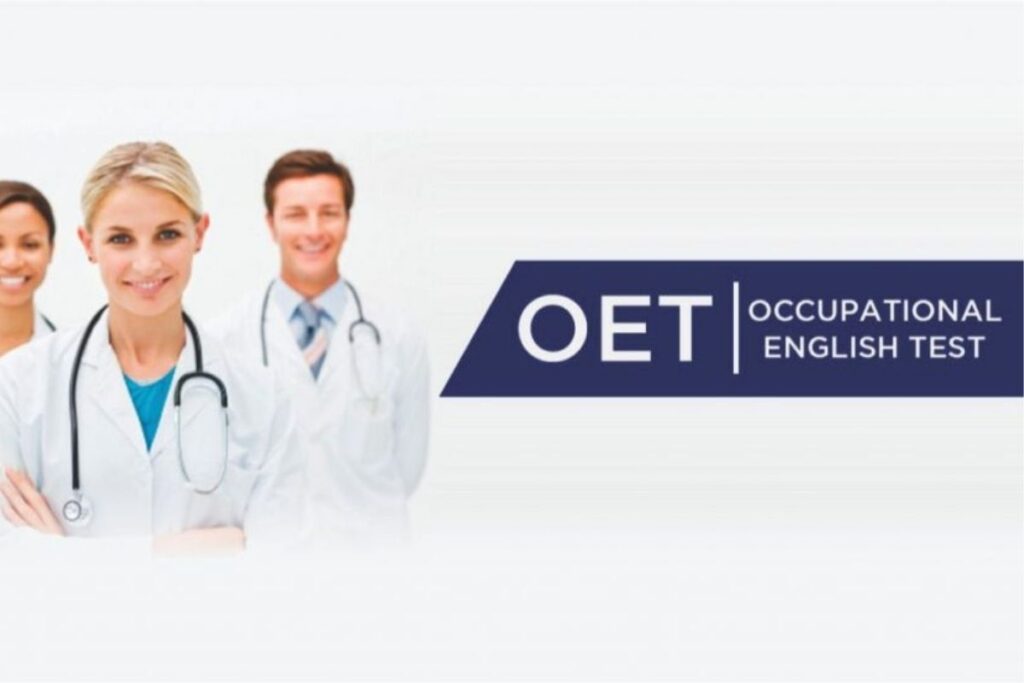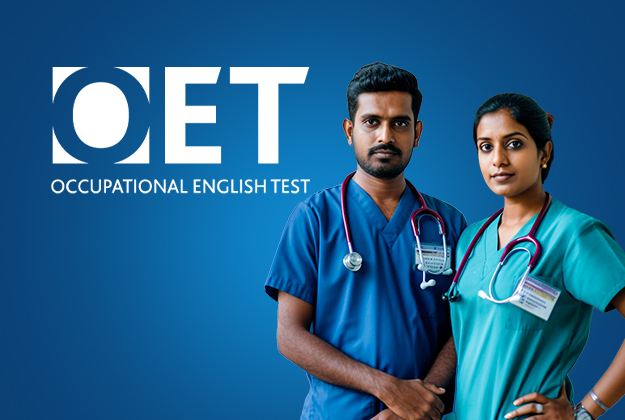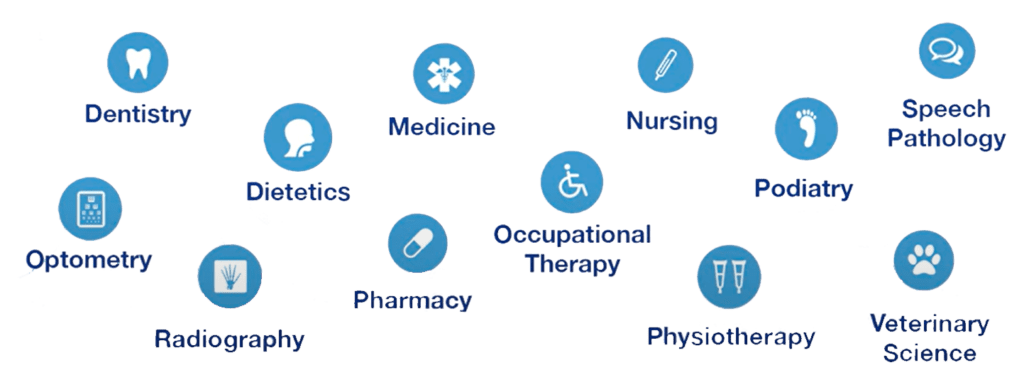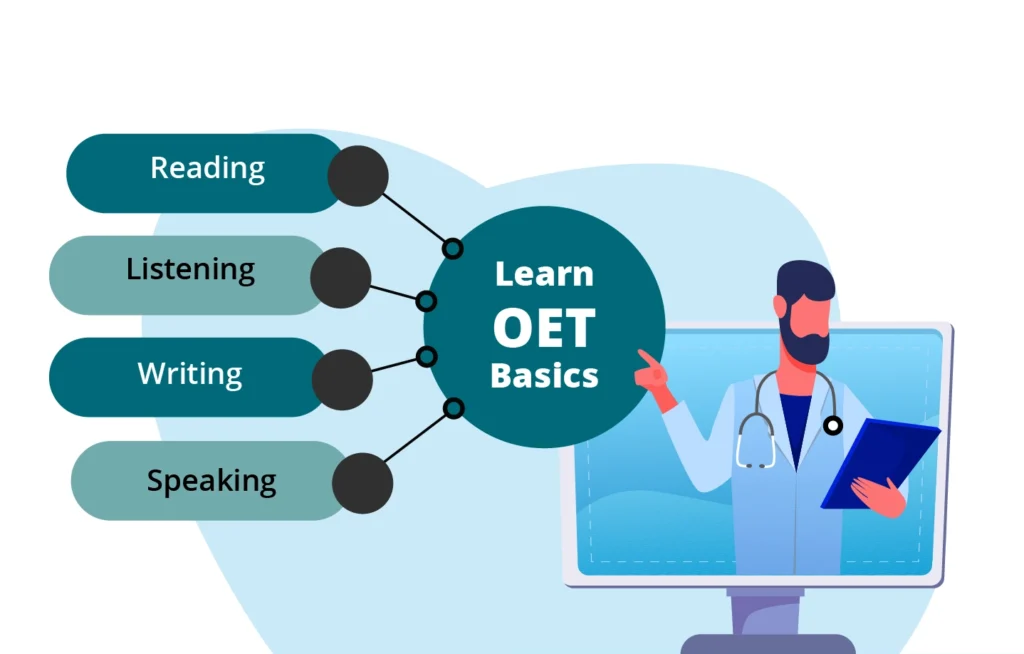Occupational English Test (OET)

Occupational English Test (OET) is an international English language test to assess the language and communication skills of healthcare professionals seeking to register and practice in an English-speaking environment.
It assesses the language proficiency of healthcare professionals who wish to practice in an English-speaking environment. All four language skills are assessed, with Writing and Speaking tests available in 12 different areas of healthcare. And All candidates sit the same Reading and Listening tests.
The Occupational English Test (OET) is accepted as proof of English proficiency in the UK, Ireland, Australia, New Zealand, Dubai, Namibia and Singapore for registration in 12 healthcare professions.
Who must take the Occupational English Test (OET) ?
Table of Contents
Toggle
The Occupational English Test (OET) is typically taken by healthcare professionals who intend to work in an English-speaking healthcare environment. Only certain countries require that those pursuing employment in the previously outlined industries pass the Occupational English Test.
In other countries, visa applicants must pass the Occupational English Test (OET). If you’re a foreign-trained medical graduate applying for medical residency in the U.S., the Occupational English Test (OET) is required. If you do not pass the Occupational English Test, you cannot become ECFMG certified or apply for the Main Residency Match.
Occupational English Test Health Professions:

- Dentistry
- Dietetics
- Medicine
- Nursing
- Occupational Therapy
- Optometry
- Pharmacy
- Physiotherapy
- Podiatry
- Radiography
- Speech Pathology
- Veterinary Science
- Doctors
Why you should take an Occupational English Test? (OET)

- Occupational English Test (OET) uses real healthcare scenarios so you’ll feel more confident on test day.
- Occupational English Test (OET) is widely recognized as proof of English proficiency for registration, study and work in the healthcare sector, as well as for visas in some countries.
- Occupational English Test (OET) helps you develop language skills for success in your career.
- It’s easy to prepare for the test using the Occupational English Test (OET) Preparation Portal.
What's in the test?

Occupational English Test (OET) covers all four language skills with an emphasis on communication in a healthcare environment. It consists of four sub-tests:
- Listening (45 minutes)
- Reading (60 minutes)
- Speaking (45 minutes)
- Writing (20 minutes)
Listening
It seems like you’re asking about the Listening section of the Occupational English Test (OET). Here’s an overview of what you can expect in the Listening sub-test:
1) Format: The Listening sub-test in Occupational English Test (OET) consists of three parts, each with 15-20 minutes allocated for different types of healthcare-related listening tasks.
2) Content: And the listening tasks are based on real-life scenarios that healthcare professionals may encounter in their daily practice.
3) Skills Assessed: This section evaluates your ability to understand main ideas, specific details, opinions, and attitudes conveyed in spoken English.
4) Task Types: The tasks may include multiple-choice questions, short-answer questions, note completion, and summary completion based on the audio recordings.
5) Timing and Conditions: You will listen to recorded extracts and answer questions while you listen. And the recordings are played only once, so concentration and effective note-taking are crucial.
6) Scoring: The Listening sub-test is scored on a scale from 0 to 500 points, with scores reported in ten-point increments. And your score reflects your ability to comprehend spoken English in healthcare contexts.
7) Preparation: It’s important to practice listening to a variety of healthcare-related materials to familiarize yourself with the types of accents, vocabulary, and situations you may encounter on the test.
Reading
1) Format: The Reading sub-test consists of three parts, each containing healthcare-related texts. The total time allocated for the Reading sub-test is 60 minutes.
2) Content: The texts in the Reading sub-test are typically authentic excerpts from sources such as medical journals, patient information leaflets, hospital policies, and healthcare-related articles.
3) Skills Assessed: This section assesses your ability to read and comprehend texts efficiently. It evaluates your understanding of main ideas, specific details, opinions, attitudes, and implied meaning in the context of healthcare.
4) Task Types: The tasks may include multiple-choice questions, short-answer questions, matching information, and summary completion based on the information provided in the texts.
5) Timing and Conditions: You are required to read the texts and answer the questions within the allocated time. Effective time management and skimming/scanning techniques are important to successfully complete the tasks.
6) Scoring: The Reading sub-test is scored on a scale from 0 to 500 points, with scores reported in ten-point increments. So, your score reflects your ability to comprehend written English texts relevant to healthcare settings.
7) Preparation: To prepare for the Reading sub-test, practice reading various types of healthcare-related texts. Familiarize yourself with different styles of writing, medical terminology. And the structure of questions typically asked in the Occupational English Test (OET).
Speaking
The Speaking sub-test in the Occupational English Test (OET) evaluates your ability to communicate effectively in English within a healthcare context. Here’s what you can expect from the Speaking sub-test:
Speaking Sub-test is Divided Into 3 Parts:
a) Part A: Introduction and warm-up conversation (2-3 minutes). This part aims to put you at ease and establish rapport with the interlocutor.
b) Part B: Role-play simulation (5 minutes). You are given a role-play card with a specific scenario relevant to your profession. You will have 2 minutes to prepare and then engage in a conversation with the interlocutor based on the scenario.
c) Part C: Professional discussion (about 10 minutes). And this part involves a more in-depth discussion related to your profession and may include topics such as patient care, treatment options, or healthcare policies.
1) Format: The Speaking sub-test consists of a face-to-face interaction between you (the candidate) and an interlocutor (the examiner). The interaction is designed to simulate a typical healthcare consultation or discussion.
2) Skills Assessed: The Speaking sub-test assesses your ability to speak clearly and fluently, organize your ideas coherently. So, use appropriate language for different situations (formal vs. informal), and respond appropriately to questions and prompts from the interlocutor.
3) Content: The topics in the Speaking sub-test are directly relevant to healthcare practice. And ensuring that your language skills are tested in contexts that mirror real-world scenarios you may encounter in your profession.
4) Assessment: Your performance in the Speaking sub-test is assessed based on criteria such as linguistic accuracy, communicative effectiveness. And the appropriateness of your responses in a healthcare context.
5) Preparation: To prepare for the Speaking sub-test, practice speaking English in healthcare-related scenarios. Work on your fluency, pronunciation, and ability to express complex ideas clearly. And familiarize yourself with common topics and vocabulary used in healthcare consultations and discussions.
Writing
1) Format: The Writing sub-test consists of one task that is directly related to your profession. You are given 45 minutes to complete this task.
2) Task Types: The task generally involves writing a letter or report based on a healthcare-related scenario.
3) Assessment: Your writing is assessed based on criteria such as task achievement (how well you address the task), coherence and cohesion (how well your ideas are organized and connected), lexical resource (your range and accuracy of vocabulary), and grammatical range and accuracy.
4) Content: The topics in the Writing sub-test are drawn from real-world healthcare scenarios, ensuring that your writing skills are tested in contexts relevant to your profession.
5) Preparation: To prepare for the Writing sub-test, practice writing letters and reports on healthcare-related topics. Familiarize yourself with the format and requirements of the task.
Timing and Results
Occupational English Test (OET) is available up to 24 times per year and can be taken at test venues around the world.
For Occupational English Test on Paper results are published online approximately days after the test OET on Computer and OET@Home results are available approximately 10 days after the test. But the official statements of results are available to download the release of online results. So, there is no overall grade – candidates receive separate grades for each sub-test.
Most organisations that recognise Occupational English Test results typically require candidates to get a B grade or higher in all four sub-tests and consider scores valid for up to two years. Additionally, these organisations usually expect candidates to achieve the necessary grades in a single attempt. However, it’s important for candidates to verify the current requirements with the recognising organisation.
What's the Difference Between IELTS and OET ?

Occupational English Test
(OET)
1) Assess English proficiency for healthcare professionals seeking to work in English-speaking healthcare environments.
2) Healthcare professionals (e.g., doctors, nurses, pharmacists)
3) Listening, Reading, Writing, Speaking
4) Healthcare-specific scenarios and language
5) Emphasis on healthcare-related tasks such as patient consultations, healthcare reports, etc.
6) Communication skills in healthcare settings, including language proficiency and contextual understanding.
7) Each sub-test varies in duration (e.g., Speaking around 20 minutes, Writing around 45 minutes).
1) Assess English proficiency for general purposes, academic studies, or work and migration in non-healthcare settings.
2) General population, students, professionals across various fields.
3) Listening, Reading, Writing, Speaking
4) General and academic English scenarios and language
5) General tasks not specific to healthcare, such as discussing general topics, describing charts, etc.
6) General proficiency in English language skills across various contexts and disciplines.
7) Total test duration is around 2 hours and 45 minutes for Listening, Reading, and Writing; Speaking test is around 11-14 minutes.
